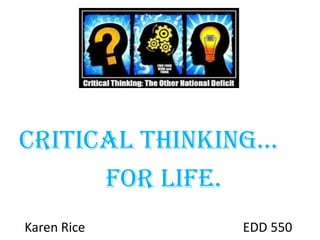
Critical Thinking...for Life.
- 1. Critical Thinking... for LIFE. Karen Rice EDD 550
- 2. Teach your students to think critically. With enough practice and by setting examples of how efficiency in thinking critically can empower them for educational success and success in life endeavors, they will be encouraged to see critical thinking as a tool to make the right decisions and/or help them solve problems that require deeper, more analytical thought processes. The power and confidence gained by making informed decisions is a worthy reward.
- 3. Some students have the natural ability to ask higher cognitive questions when evaluating experimental findings in science or solving math problems. However, many students do not have this innate skill and need to learn how to ask higher order questions. A teacher can encourage students to use critical thinking is by modeling these skills for her students. Students will inherently follow their teacher’s lead; this is why it is important to practice what we preach.
- 4. Why do we need to provide plenty of critical thinking opportunities in science and math? The purpose of science is to learn about and understand the world around us. And, in order to accomplish this, we need to participate in activities and conduct experiments. As rookie scientists, students need to analyze, synthesize, compare, question, draw conclusions, predict, and evaluate among other skills. They need to be able to figure out the accuracy of their solutions and findings. With maximum knowledge about each of the various science disciplines, humans can have healthy and convenient living. In another branch of science, we have engineering. Engineers solve problems and design solutions to meet human needs. Higher order thinking and engineering go hand- in- hand.
- 6. Critical thinking opportunities in math are equally necessary. Memorizing formulas, theorems, postulates, and equations will only take the learner so far. Students who are successful in math have general math sense that they can apply in their higher order thinking. Critical thinking in math deals with understanding relationships and the whys, and hows, and ifs. When presented with a problem, an effective math student will be able to comprehend/process what the question is asking. The first step of an effective math student is to understand the problem; he would not just act spontaneously to create an algorithm that would satisfy only one part of the problem.
- 7. Where do we find opportunities to encourage critical thought processes? In the following (grades 6 thru 8) lesson that integrates math, earth science, and geography students need to use critical thought processes to learn and understand the reasons for the climate differences among three United States regions: Denver, New Orleans, and Phoenix.
- 8. Denver (an inland city) New Orleans (located on the Gulf) Phoenix (located on the Sonoran Desert)
- 9. Within this lesson there will be opportunities for critical thinking related to both math and science. The students will learn how meteorologists collect different kinds of weather data, including temperatures and rainfall that occur on a daily and/or monthly basis. With this information, the students will create a graph that compares these three climates.
- 11. To begin, we can encourage critical thinking by asking the students to make predictions about the cities’ climates and to support their predictions with statements of reason. In order to make predictions and to reason, students will need to access their prior knowledge: Lower cognitive knowledge, such as knowing facts (i.e. I know that land next to bodies of water have more moisture and rainfall.) assists the learner with higher cognitive learning (critical thinking). And, in this lesson, prior knowledge pertaining to the geographic location of these cities becomes useful for critical thought (reasoning for the purpose of making predictions) as well. Are they near the equator where temps are warmer and/or humidity is higher? Reasonably, there is still an obvious need for lower cognitive learning in classrooms as well. For without knowledge of facts and basic understanding of why things are the way they are, the ability to think critically is compromised.
- 12. Critical thinking can open the lesson: What kinds of animals and plants grow in the desert? Why? Ask students to look at the data on the average daily high temperatures chart . Ask if someone can interpret and explain what these temperatures mean. Explain that daily high temperatures are averaged together to find the average monthly temperatures. Ask students to choose a month or two from the average daily high temperatures chart and calculate the monthly average. They can check their answers on the monthly averages chart . Have students note the rainfall data on the chart. The rainfall data for each month was averaged together to get these figures in the same way that students have just averaged the temperatures. *right-click to open hyperlinks, please.
- 13. Sources: • Cotton, Kathleen, Classroom Questioning, North West Regional Educational Laboratory. • Paul, Richard, Critical Thinking: How to Prepare Students for a Rapidly Changing World, Foundation for Critical Thinking. • Alabama Learning Exchange http://alex.state.al.us/plans2.php?std_id =40896 • National Geographic Education natgeoed.org • Xpedition- http://www.nationalgeographic.com/xpeditions/ hall/